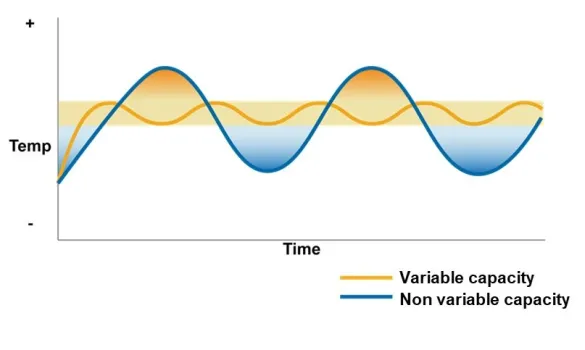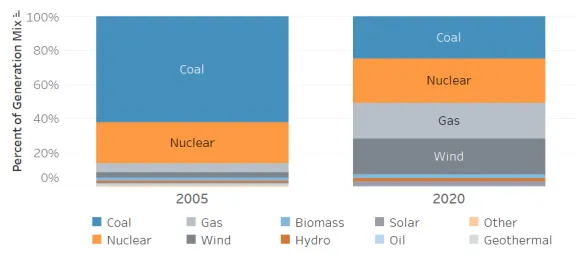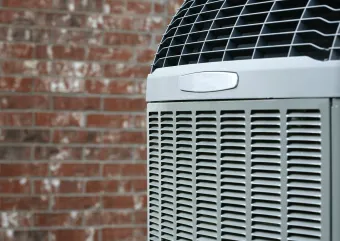When is the best time to replace an AC? For equipment older than 15 years, waiting too long to replace could mean the equipment breaks when you need it most. This leads to expensive emergency service calls and limited equipment replacement options. To avoid that stress, expense, and lack of options, make a replacement plan beforehand. Before you decide on swapping in another standard AC unit, consider the benefits of upgrading to a high-efficiency, cold-climate rated air source heat pump.
A heat pump is essentially an AC that can run two ways, providing heating in addition to cooling. If you use propane to heat your home, heat pumps are a great investment. Replacing an AC with a cold-climate heat pump saves you money on energy bills year-round, increases your comfort, and is better for the environment.
Heat pumps slash energy bills
Cold-climate heat pumps are more energy efficient than standard ACs. Beyond saving money in the summer, cold-climate heat pumps will really show their value in the winter.
A cold-climate heat pump can reduce your propane use by up to 55%. This can prevent expensive propane refills during the winter. It also opens the possibility of filling a tank only once in the summer when prices are lower.
According to CEE’s energy calculations, a cold-climate heat pump that provides heating down to -10°F will achieve the maximum savings. The heating source switches from the heat pump to the propane furnace when the outside temperature dips below that point (called the “switchover temperature”).
With this setup and a standard electric rate, you can save up to 30% compared to a traditional propane furnace and standard AC system. Additional savings are possible by signing up for a “dual fuel” or “off-peak” program offered by many Minnesota utilities. These programs are for customers who have a heat pump plus a furnace for heating and provide the best way for propane customers to maximize an investment in a cold-climate heat pump.
Can a single-stage or two-stage heat pump achieve these savings? In this situation, a variable capacity, cold-climate rated heat pump is needed. These are also sometimes called variable speed or inverter driven heat pumps. These modern, high-efficiency heat pumps are specially designed with the capacity to deliver heat in cold temperatures.
When requesting quotes from a contractor, make sure to specifically ask to see options that have cold-climate certification. To check whether a unit you have been quoted meets the qualifications, search the cold-climate heat pump list. If the equipment is listed, it is qualified. Ask the contractor for the unit’s AHRI’s number to make the search easier.
Cold-climate heat pumps do carry a higher price tag compared to standard ACs. Over time, this higher upfront cost will be offset by lower annual energy bills. In addition, many Minnesota electric utilities offer generous rebates that can often be stacked with seasonal manufacturer rebates offered in spring through early summer. These incentives bring the initial cost down and help ease the transition from a standard AC to a cold-climate heat pump. We have done your homework for you with our simple search page for rebates and promotions.
Heat pumps offer better comfort
In addition to the financial benefits, cold-climate heat pumps are quieter and keep living spaces more comfortable than standard ACs. This is due to their special variable capacity compressor.
Single-stage systems that are used in standard AC can only turn on and off. This can create a condition called short-cycling. An AC that is short-cycling will turn on and off frequently, which produces wider temperature variation and hampers dehumidification. Furnaces can also be subject to short cycling during mild temperatures.
Variable capacity compressor units can incrementally ramp up or down their operation to consistently hold the temperature you set. The figure below shows how a variable capacity unit (inverter) maintains a tighter temperature than a standard system.

A variable capacity unit can operate at low power for long periods of time. This mode does a better job at holding a consistent temperature, has improved dehumidification, and is highly energy efficient. Variable capacity heat pumps can also ramp up operation when extra power is needed, allowing them to operate in much colder temperatures than standard heat pump systems.
Heat pumps run on cleaner energy
Besides cost and comfort benefits, heat pumps will be powered by increasingly cleaner electricity, so powering a portion of your heating with one will result in net emissions savings over the system’s lifetime.
Nationwide, 40% of a home’s energy use is attributed to heating. In Minnesota, that percentage can be as high as 80% because of our colder winters. Supplying this heat with clean energy is a very effective way to reduce household carbon emissions.
The electrical grid in Minnesota is rapidly becoming greener through the addition of lower cost, local renewable energy. The state and utilities are both working to accelerate this process, and in some cases, they are ahead of schedule. However, not all electric heating is equal. Electric baseboards and space heaters can only reach 100% efficiency and are expensive to run. Modern, cold-climate heat pumps are a more advanced technology that can reach efficiencies as high as 350%. Cold-climate heat pumps make best use of a continuously lower emitting electric grid to supply most of your heating and cooling.

The benefits of upgrading to a heat pump from an AC
One of the most cost-effective opportunities to make the switch to a cold-climate heat pump system is when your AC needs replacing. Instead of defaulting to another standard AC unit, consider an upgrade to a cold-climate heat pump system to save money on cooling, cut propane expense, and keep your home more comfortable with greener energy.
Looking for more guidance?
To learn more about heat pumps, continue exploring News & Case Studies or visit the FAQs page. If you have further questions, contact us at info@mnashp.org.

